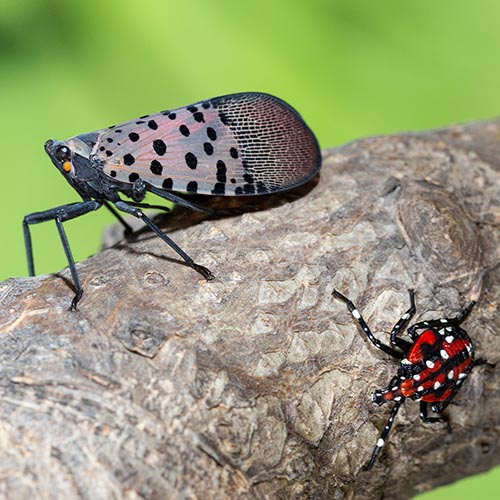
Listen to this Episode:
- From this webpage:
- Find the media player located under the episode picture.
- Click on the green triangle to listen to the audio for this episode.
- From your favorite podcast listening platform:
- Search for “Backyard Ecology.”
Show notes:
The spotted lanternfly (Lycorma delicatula) is an invasive species of leafhopper (a type of insect) that was accidentally brought to the U.S. from Asia. It was first detected in Pennsylvania in 2014 and has spread to multiple states since then.
This episode of the Backyard Ecology podcast is all about the spotted lanternfly and is a little different than most episodes, because I don’t just have one guest – I have four guests. Each of the guests on this episode represents a different part of the spotted lanternfly story and response.
Erin Otto is the National Policy Manager for the spotted lanternfly and is with the USDA’s Animal and Plant Health Inspection Service or APHIS. She joins us to help us understand the overarching work and coordination at the national level in regard to spotted lanternflies.
Dana Rhodes is the Pennsylvania Department of Agriculture’s State Plant Regulatory Official. She brings with her the “been there, done that” wisdom, experiences, and lessons learned of a state that has been dealing with spotted lanternflies for several years now.
Subba Reddy Palli is Kentucky’s State Entomologist and a Department Chair at the University of Kentucky. He represents those states that are on the leading edge, don’t have spotted lanternflies yet, and would like to keep it that way for as long as possible.
Tracy Leskey is a Research Entomologist and Director at the USDA’s Appalachian Fruit Research Station. Tracy joins us to share some of the research going on related to spotted lanternflies. The researchers aren’t always the most visible individuals when it comes to emerging threats, but the work they do is vital to helping resource managers and others better understand the threat and ways to stop it, or at least manage it.
Our conversation covers a wide range of topics including basic biology of the spotted lanternfly, information about its life cycle, the impacts caused by the spotted lanternfly, how it spreads, ways to manage it, current research, and much more. One of the points that came up over and over again in our conversation is how this is such a collaborative team effort. Federal agencies, state agencies, cities and local municipalities, universities, corporations, industries, and private individuals are all working together to address the spotted lanternfly. We all have a role to play when it comes to combatting this invasive species.
Links:
- National Plant Board’s members page: https://www.nationalplantboard.org/members.html
- Penn State Extension spotted lanternfly page: https://extension.psu.edu/spotted-lanternfly
- Pennsylvania Department of Agriculture spotted lanternfly page: https://www.agriculture.pa.gov/Plants_Land_Water/PlantIndustry/Entomology/spotted_lanternfly/Pages/default.aspx
- Stop SLF website: https://www.stopslf.org/index.cfm
- USDA APHIS spotted lanternfly page: https://www.aphis.usda.gov/aphis/resources/pests-diseases/hungry-pests/slf/
- Backyard Ecology’s website: https://backyardecology.net
- Backyard Ecology blog: https://www.backyardecology.net/blog/
- Backyard Ecology’s Patreon page: https://www.patreon.com/backyardecology
- Subscribe to Backyard Ecology emails: https://www.backyardecology.net/subscribe/
- My email: shannon@backyardecology.net
Episode image:
- Spotted lanternfly (Lycorma delicatula) winged adult and 4th instar nymph.
- Photo credit: U.S. Department of Agriculture, public domain

Backyard Ecology: Exploring Nature in Your Backyard
Nature isn’t just “out there.” It’s all around us, including right outside our doors. Hi, my name is Shannon Trimboli, and I am the host of Backyard Ecology. I live in southcentral Kentucky and am a wildlife biologist, educator, author, beekeeper, and owner of a nursery specializing in plants for pollinators and wildlife conservation. I invite you to join me as we ignite our curiosity and natural wonder, explore our yards and communities, and improve our local pollinator and wildlife habitat. Learn more or subscribe to my email list at www.backyardecology.net.

Leave a Reply